 I’ve always been a huge comic book fan. I grew up ready many of the titles from Marvel and DC comics. So when I found out that both Marvel and DC have licensed a deck building card game, I took an immediate interest.
I’ve always been a huge comic book fan. I grew up ready many of the titles from Marvel and DC comics. So when I found out that both Marvel and DC have licensed a deck building card game, I took an immediate interest.
Between the two different games, Legendary: A Marvel Deck Building Game (Legendary from here on out) seemed the most interesting to me. In Legendary, players assemble a team of super heroes from the Marvel universe to try and thwart the schemes of an evil Mastermind. Does Legendary have the power to be a hero in the fast growing deck-building genre or does it get KO’d? Read on to find out.
Legendary is a deck building game set in the Marvel universe for 1-5 players. It has a play time of about 45 minutes and works well with any number of players.
Game Overview:
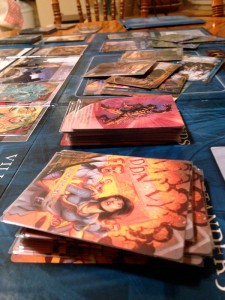
In Legendary, players take on the role of a S.H.I.E.L.D. agent, assembling his team to stop the scheme of an evil Mastermind. Each players starts with a small deck of 12 S.H.I.E.L.D. agents to work with. These cards provide either recruit power (the game’s currency) or fight power (how you fight the villains).
Over the course of the game, players will recruits super heroes to their deck, giving them much stronger fight power, higher recruiting power and unique special abilities.
As a player fights and defeats villains, they gain victory points towards being the individual winner. If the players defeat the Mastermind’s scheme, they collectively win the game. Fail to stop the Mastermind’s scheme and everybody loses.
After the Mastermind is defeated, players tally up their VP cards and see who the individual winner is. Legendary is an odd sort of game that is both cooperative and competitive. It takes some getting used to, but more on that later.
Components:
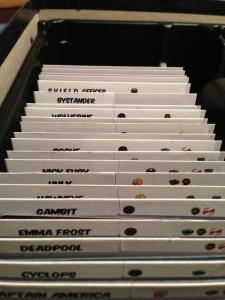
While Legendary has some great components, there are also some minor gripes to be had with them. In general though, Upper Deck (the game’s publisher) did a lot of things right when designing this game.
First, the cards. You get 500 cards of various types (Super Heroes, Villains, Henchmen, Bystanders, etc…). The first thing I thought of when I saw all those cards was “Damn, now I have to buy 500 sleeves.” While sleeving isn’t required, if you are anal-retentive about the condition of your games as I am, sleeving is a requirement. So I spent some time watching Law & Order reruns while I sleeved up my cards.
If you are a fan of the Marvel universe, then you will love the artwork on these cards. All of the artwork was created just for this game, so you won’t see any comic book reruns here. They down side is that there is only one piece of art for each card type. So while Spider-man may have 14 cards in his stack, each has the same piece of art. Not a huge issue, but a minor gripe. It would have been nice to see each card type have its own unique art.
I should also mention that the graphic design on the cards could have been a little better. The titles are sometimes hard to read over the artwork, due to the low contrast between the type and the background. Once again, a minor gripe, but something that could have been easily fixed.
The game also comes with a large game board to hold all the cards during play. The board fantastically illustrated and contains some useful quick reference tables. Upper Deck also did us a large favor by including 60 divider cards and a well designed storage try. I do wish that the divider cards were pre-labeled, as I’m way too anal to label them by hand. I ended up printing labels to stick on them. But, once again, only a minor gripe.
How To Play:
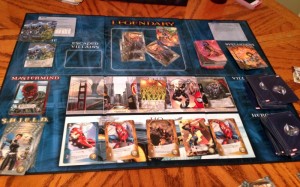
If you are not familiar with how a deck building game works, I’d suggest checking out our review of Dominion. That’s a great intro into the deck building genre.
The setup of the game takes a little bit of time. The villain deck must be created (Consisting of Villains, Henchmen, Bystanders, Scheme Cards and Master Strikes). Then the hero deck must be built. You chose 5 different super heroes to play during the game and all of their cards are shuffled into 1 big deck. You then deal 5 heroes into the HQ for recruiting and you’re ready to play.
The turns are actually quite easy and broken down into 3 steps:
1. Villain Phase
2. Recruit and Battle
3. Cleanup
1. Villain Phase. Play the top card of the villain deck. If it’s a Villain it goes onto the villain track. The track is a series of 5 different locations around the city. As the villains progress along the track, they get closer to escaping from the heroes (bad stuff can happen if they do). Each villain has a fight strength and some unique abilities.
Other cards that may appear are bystanders (who get captured by villains), Scheme cards (the effect varies depending on the Masterminds scheme), and Master Strike cards (which are basically the Mastermind getting his hands dirty and pounding on the players).
2. Play cards from your hand to recruit and fight. This is where you can add cards to your deck or battle the villains and mastermind. Almost all of the super hero cards will have either a recruit number or fight number. You use your recruit points as a form of currency to add heroes from the HQ to your play deck. Fight points are used to battle the villains on the villain track. If your fight points equal his fight value, you KO him and he is added to your score pile.
Hero cards also will usually have a special ability that will help the player in some way (such as drawing more cards or adding to other cards fight/recruit power).
3. Discard your hand and draw 6 new cards. This is the standard cleanup phase found in most all deck building games. Discard everything in play/hand and draw 6 news cards.
And that’s it. The only new game concept here is the villain phase. After a round or two, players should be comfortable with the turn structure and what all the symbols mean. If the players KO the Mastermind 4 times, they win the game and whoever has the most points in their score pile is the individual winner.
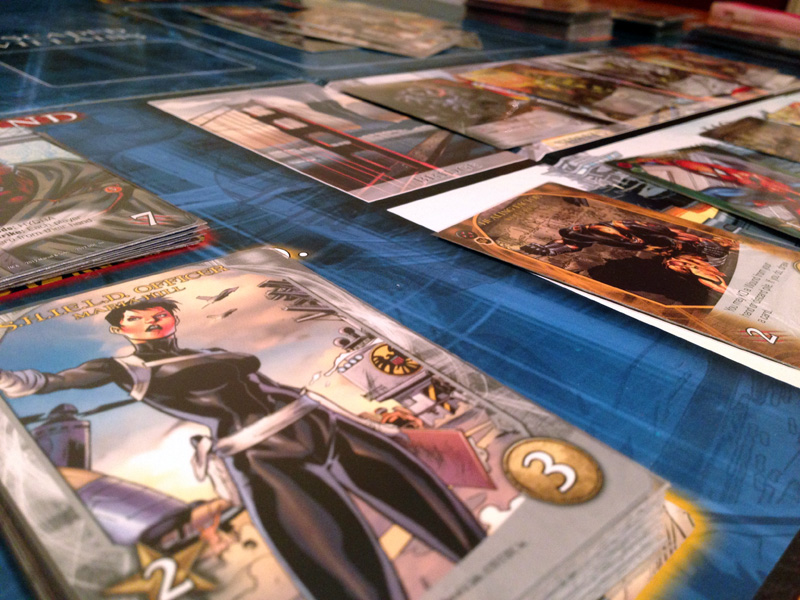
Game Experience:
Right off the bat I can say with certainty that I enjoy playing Legendary. It’s fast paced, there is a decent amount of strategy and I love the theme. As a huge Marvel fan, it was a lot of fun to play with all the different heroes I already love reading about.
The game comes with 15 different Marvel heroes and you use 5 in any given game. That makes a possible combination of 3,003 different hero teams you can have in a game. That’s a lot of different options for a game.
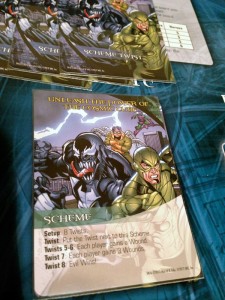
Another thing for you to consider is how you are going to play the game. If you are going to play Legendary as a purely cooperative game, I think you will find it fairly easy to win. That’s actually a rarity in the cooperative genre, and for good cause. If a game is too easy, players will lose interest quickly. In all of the games we’ve played, we never really had that feeling of barely keeping your head above water. I remember playing Pandemic and Ghost Stories and always feeling like we were on the verge of losing. In Legendary, the game never feels that rough. The rule book does give some options to make the game harder, but we haven’t tried any of those yet. I think those will probably become necessary after a few more plays. I would say that if you are planning on playing with little children, fully cooperative is probably way to go.
However, for games with your friends, I’d suggest treating this as a competitive game that requires a little bit of cooperation. I’ve found that to be the best way to play Legendary. While everyone needs to try and beat the Mastermind to win the game, I want to be the person with the most VPs at the end (the real winner). The in-game competition adds another level of fun and excitement to the game that you won’t have if you treat it as a straight cooperative game. It will also allow you to avoid feeling dissatisfied with the game after a few easy wins. Thematically it can make sense, as a lot of super heroes have a big ego and they are all constantly fighting each other anyway. As a competitive game, it fits in with the deck building genre nicely and it’s a nice twist that everyone can lose the game if it becomes too cutthroat.
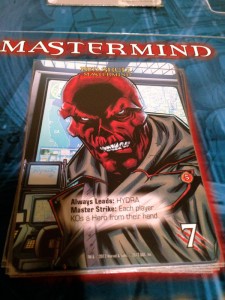
The game comes with 4 Masterminds (Loki, Red Skull, Magneto and Dr. Doom) and 8 different schemes. Each Mastermind can use each scheme, so that gives you 128 different ways you can fight against the game. Once again, Legendary is solid with replay value. And that’s not even factoring in the eventual expansions, which I cannot wait for. This game is just begging for more heroes, schemes and Masterminds.
As far as game mechanics go, I have no complaints with Legendary. Turns will go by quickly, down time is minimal and KOing villains is very satisfying. As with any deck builder, luck is a part of this game. If you draw a hand full of recruit cards, fighting a henchman will not be an option that turn. That’s something you’ll have to be ok with to enjoy this game. But anyone who is that strongly against luck in a game probably isn’t going to be playing a deck builder anyway.
As far as deck builders go, it is one of our favorites. The artwork on the cards is stunning, the theme is immersive and the game leaves you wanting to play again. I can see some influences from other games in the mechanics (Dominion, Ascension), but that’s not a bad thing. The game works quite well and despite the minor gripes mentioned earlier.
Final Thoughts:
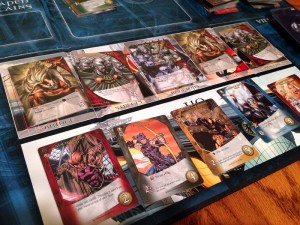
If you are a fan of deck building games or super heroes (or both), Legendary becomes and each choice. It’s a solid deck building game with a healthy mix of cooperative and competitive game play. Just make sure you are going in knowing what you are getting. If you are looking for a purely cooperative game, I’d steer clear of Legendary. But if you are ok with a competitive game what has some cooperative elements mixed in, you’d be hard pressed to find a more entertaining game.
It’s also worth noting that some comic fans might be turned off by the fact that it’s a team recruiting game instead of each player choosing a single hero. If you are looking to just play as Wolverine, you will probably walk away disappointed. However, if you think it’d be fun to recruit a team of different Marvel heroes to do battle with, then I think you will really enjoy Legendary.
With fantastic artwork, lots of high quality components, a quick and fun play time, Legendary is a KO in my book. Grab a copy today and start recruiting your team.
If you are interested in getting a copy for yourself, it’s about $50
Final Score: 4 Stars – A great deck builder that will appeal to comic fans and board gamers alike.
 Hits:
Hits:
• Combination of cooperative and competitive game play
• Great theme if you are a fan of Marvel
• High quality components
• Unique twist on the deck building genre
Misses:
• Too easy if played as a purely cooperative game
• Some minor graphic design gripes





















I hope that with this review you also do a comparison with the DC Deck Builder. Personally, I prefer Marvel over DC, but after playing both of the deck builders I opted for DC. I won’t say why in case you haven’t played it.
I do hope to be able to do a comparison report someday between the two. However, I haven’t been able to play the DC game yet. I’ve only read about it. It will happen though!
Great Review. I really must play this.
I like how you labeled the dividers. Did you have to print out 60 labels? What labels did you use, and what did you put on them “can’t quite tell from the pic what the dots are”.
The whole group of labels actually only took 1 sheet of label paper. I used the Avery 5167 label paper (it’s what I had on hand). It worked out pretty well. I posted the file I used here
The dots are the powers and teams each hero has. It’s nice to have when choosing heroes to make sure you get a diverse group.